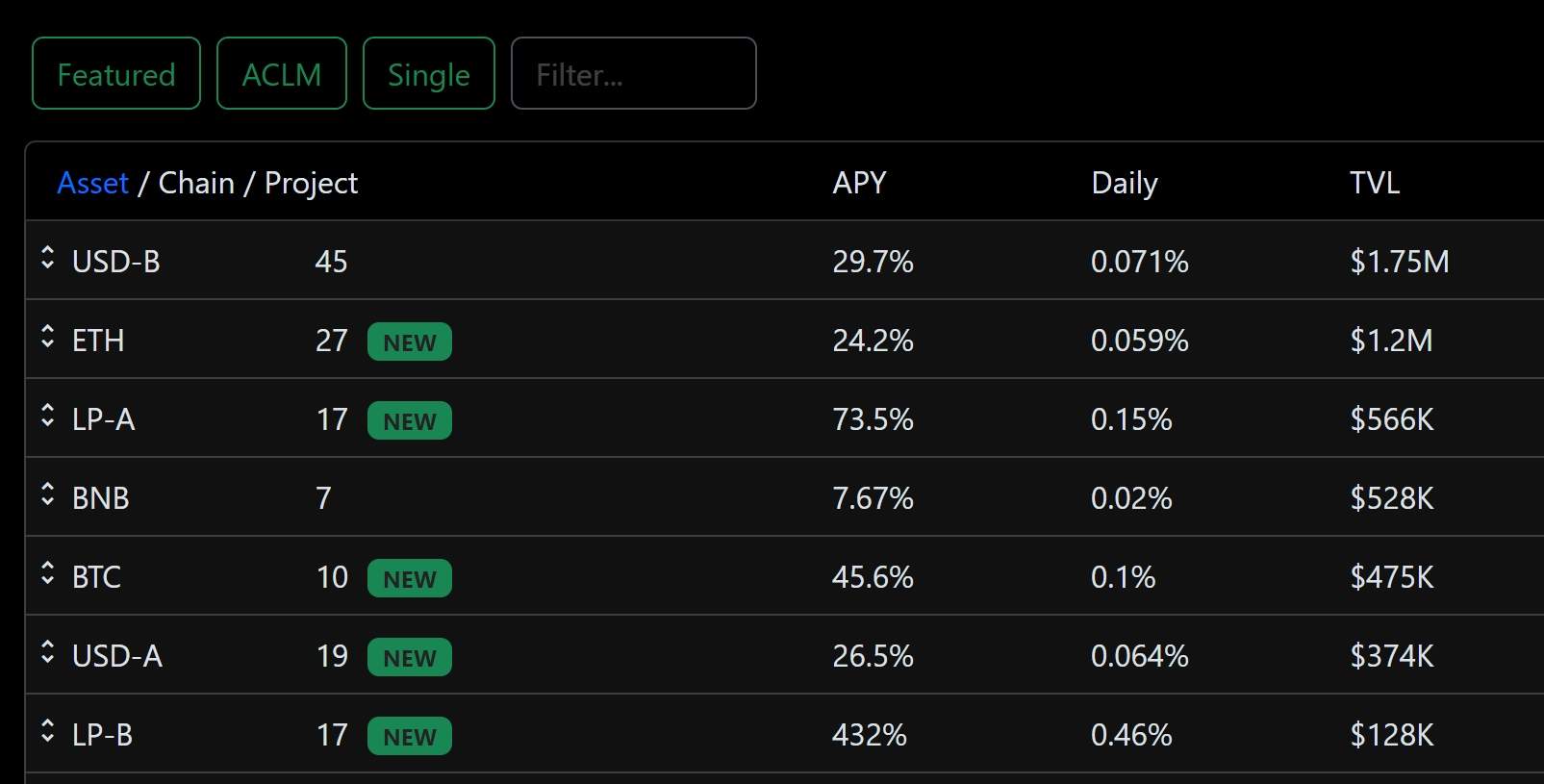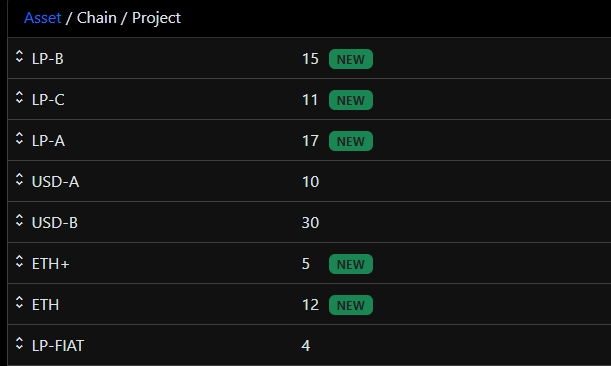Quick-Start Guide
Getting to know our UI and how to pick between vaults.

Vault Comparisons
You see some great yields on our dapp: there's Single-Token vaults, and ACLM vaults - but you're not too sure which to pick. What are the risks involved? What tokens do you receive as APY? etc.
This will help you out. 👇
Built On
lending protocols, eg. Venus, Moonwell
CL DEXs, eg. UniswapV3, SushiV3
CL DEXs, eg. UniswapV3, SushiV3
APY Source
supply/borrow APY + lending platform tokens
swap fees generated from trading volume + *Merkl rewards
swap fees generated from trading volume + *Merkl rewards
Strategy Features
self-balancing for optimized highest APY
-single-sided deposits of either token.
-auto range setting to ensure earning of swap fees
-Tightened range for highest stable pair APY
-single-sided deposits of either token.
-auto range setting to ensure earning of swap fees
Examples
-USDT
-wstETH
-BTC
-LINK
-USDC-DAI
-USDC-USDC.e
-wstETH-WETH
-cbETH-rETH
-WBTC-tBTC
-MATIC-USDT
-LINK-WETH
-BTC-WETH
-USDC-XSGD
More detailed comparisons here:
-lending protocol exploits
-no IL risks
-CL DEX exploits
-low chances of IL
-CL DEX exploits
-high IL risks
Considerations
-exposure to 1 token
-slower growth of tokens
-high APY vaults less sustainable (as mainly coming from lending platform tokens)
-exposure to 2 tokens
-higher APY, for relatively low IL risk
-rewards sustainable via swap fees
-exposure to 2 tokens
-highest APY, but gains easily negated by IL
-rewards sustainable via swap fees
Rewards
auto-compounding into deposited tokens
auto-compounding into deposited tokens
auto-compounding into deposited tokens
Categories

A category of higher quality stablecoins vaults, built on USDC and its bridged counterparts.
USDC.e (bridged USDC on chains before USDC was natively available)
axlUSDC (bridged USDC by Axelar)
USDbC (bridged USDC by Base chain)
xcUSDC (XCM protocol USDC on Polkadot parachains)
Examples:
Single-Token Vaults
USDC on Venus (BSC)
USDC.e on Lodestar (Arbitrum)
USDbC on Moonwell (Base)
xcUSDC on Moonwell (Moonbeam)
ACLM - Stable Strategies
USDC.e / axlUSDC on UniswapV3 (Polygon)
USDC.e / USDC on UniswapV3 (Optimism)
USDbC / axlUSDC on SushiswapV3 (Base)
A category of stablecoins from various protocols, ranging from large marketcap to algorithm pegged USD stable tokens. Stablecoin pools paired with USDC also fall under this category.
USDT (USD by Tether)
centralized stablecoin pegged to the US dollar
largest marketcap among stablecoins
DAI by MakerDAO
largest decentralized stablecoin pegged to the US dollar
algorithmically backed by a basket of cryptocurrencies, primarily ETH
USDC.e (bridged USDC on chains before USDC was natively available)
axlUSDC (bridged USDC by Axelar)
USDbC (bridged USDC by Base chain)
xcUSDC (XCM protocol USDC on Polkadot parachains)
xcUSDT (XCM protocol USDT on Polkadot parachains)
Examples:
DAI on Venus (BSC)
USDT on Moonwell (Optimism)
USDT on Mendi (Linea)
xcUSDT on Moonwell (Moonbeam)
FRAX on Lodestar (Arbitrum)
ACLM - Stable Strategies
USDC.e / DAI on UniswapV3 (Optimism)
USDT / BUSD on PancakeswapV3 (BSC)
USDT / USDC on UniswapV3 (Linea)
DAI / USDbC on SushiswapV3 (Base)
A category of various types of wrapped and liquid staked BTC.
WBTC - centralized and largest marketcap wrapped BTC by BitGo
tBTC - decentralized wrapping by Threshold Network
BTCB - centralized and pegged by Binance
BTC.b - decentralized wrapping by Avalanche Network
uniBTC - liquid restaking WBTC by Bedrock
cbBTC - coinbase wrapped BTC
Examples:
Single-Token Vaults
WBTC on Moonwell (Optimism)
WBTC on Mendi (Linea)
BTCB on Venus (BSC)
cbBTC on Moonwell (Base)
ACLM - Stable Strategies
WBTC / BTC.b on UniswapV3 (Arbitrum)
WBTC / uniBTC on UniswapV3 (Optimism)
WBTC / tBTC on SushiswapV3 (Arbitrum)
A category of various types of wrapped and liquid staked ETH.
WETH - wrapped ETH on non Ethereum chains
wstETH - liquid staking ETH by Lido
rETH - liquid staking ETH by RocketPool
cbETH - liquid staking ETH by Coinbase
weETH - liquid staking ETH by Ether.fi
wBETH - liquid staking ETH by Binance
ezETH - liquid restaking ETH by Renzo
Examples:
Single-Token Vaults
WETH on Mendi (Linea)
wstETH on Lodestar (Arbitrum)
cbETH on Moonwell (Base)
rETH on Moonwell (Optimism)
ACLM - Stable Strategies
wstETH / WETH on UniswapV3 (Optimism)
cbETH / WETH on SushiswapV3 (Base)
ETH / wBETH on BiswapV3 (BSC)
Find out more on why our Stable Strategies work so well for LST vaults.
An ACLM category where liquid staked ETH from different platforms are paired together in a pool.
Examples:
ACLM - Stable Strategies
wstETH / ezETH on UniswapV3 (Optimism)
cbETH / rETH on UniswapV3 (Base)
wstETH / rETH on UniswapV3 (Arbitrum)
Find out more on why our Stable Strategies work so well for LST vaults.
A category of various types of wrapped and liquid staked BNB.
WBNB - wrapped BNB by Binance
ankrBNB - liquid staking BNB by Ankr
BNBx - liquid staking BNB by Stader
stkBNB - liquid staking BNB by pSTAKE
slisBNB - liquid staking BNB by Lista (previously Synclub staked SnBNB)
Examples:
Single-Token Vaults
WBNB on Venus (BSC)
ACLM - Stable Strategies
WBTC / ankrBNB on PancakeswapV3 (BSC)
WBTC / BNBx on PancakeswapV3 (BSC)
WBTC / stkBNB on PancakeswapV3 (BSC)
A category of ACLM vaults, consisting of large marketcap token pairs.
WMATIC
WETH
WBNB
WBTC
tBTC
BTCB
BTC.b
OP
ARB
IL is relatively lower than other pairs as prices for large marketcap tokens generally move in the same direction.
*Take note that IL may negate any gains, or result in losses on the intial deposit. Refer to the History Graph in the Advanced section of each vault to evaluate their past performance.
Examples:
ACLM - Volatile Strategies
BTCB / WBNB on PancakeswapV3 (BSC)
WETH / ARB on SushiswapV3 (Arbitrum)
WETH / OP on UniswapV3 (Optimism)
WMATIC / WBTC on UniswapV3 (Polygon)
tBTC / WETH on UniswapV3 (Arbitrum)
A category of ACLM vaults, consisting of smaller marketcap tokens paired with large marketcap tokens.
*Liquidity for our ACryptoS governance token pair ACS / WBNB can be found in this category as well.
Some of the tokens available:
BSW, LODE, VELA, THALES, GMX, XVS, PEPE, CAKE, MAGIC, TIA.n, CRV, UNI, LINK
IL may be higher for these pairs as prices tend to fluctuate much more for lower marketcap tokens.
*Take note that IL may negate any gains, or result in losses on the intial deposit. Refer to the History Graph in the Advanced section of each vault to evaluate their past performance.
Examples:
ACLM - Volatile Strategies
CAKE / WBNB on PancakeswapV3 (BSC)
LINK / WETH on UniswapV3 (Arbitrum)
PEPE / WETH on UniswapV3 (Arbitrum)
CRV / WETH on UniswapV3 (Arbitrum)
UNI / WETH on UniswapV3 (Arbitrum)
BSW / WBNB on BiswapV3 (BSC)
A category of ACLM vaults, consisting of stablecoin tokens paired with mainly large marketcap tokens.
IL may be very high for these pairs as fluctuating token prices are amplified when paired with stablecoin tokens.
*Take note that IL may negate any gains, or result in losses on the intial deposit. Refer to the History Graph in the Advanced section of each vault to evaluate their past performance.
Examples:
ACLM - Volatile Strategies
WBNB / USDT on UniswapV3 (BSC)
wstETH / USDC.e on UniswapV3 (Arbitrum)
MATIC / USDT on UniswapV3 (Polygon)
WETH / USDbC on UniswapV3 (Base)
WETH / USDC on SushiswapV3 (Arbitrum)
A category of stablecoins from different currencies, paired with the USD stablecoin.
IL is minimal, as pegged fiat currencies are much less volatile than other crypto tokens. Token unpeg risk has to be factored in as part of risk assessment as well.
XSGD by StraitsX
EURC by Circle
ACLM - Volatile Strategies
XSGD / USDC.e on UniswapV3 (Polygon)
XSGD / USDC on UniswapV3 (Arbitrum)
EURC / USDC on UniswapV3 (Base)
Risks
DeFi risks are very high compared to traditional finance, ranging widely from market factors to contract exploits. Here are some risks for consideration along with possible mitigations. Factor in your own risk appetite when deciding on which vaults to deposit your tokens in.
Only put in funds you can afford to lose. Do not risk your life savings on DeFi.
Read more about risks and mitigations here.
Fees
Withdrawal Fees: All vaults have a 0.1% withdrawal fee, calculated by the withdrawal amount.
Performance Fees: already factored into the displayed APY. Full details can be found here.
All fees go to ACryptoS Treasury, used for frequent buybacks of the $ACS token.
Treasury is owned by ACryptoS DAO ($ACS token holders), managed by a multisig.
Next Steps 🚀
Interested to gain yields via our vaults? Check out this step-by-step visual guide.
Step-by-step GuideLast updated
Was this helpful?